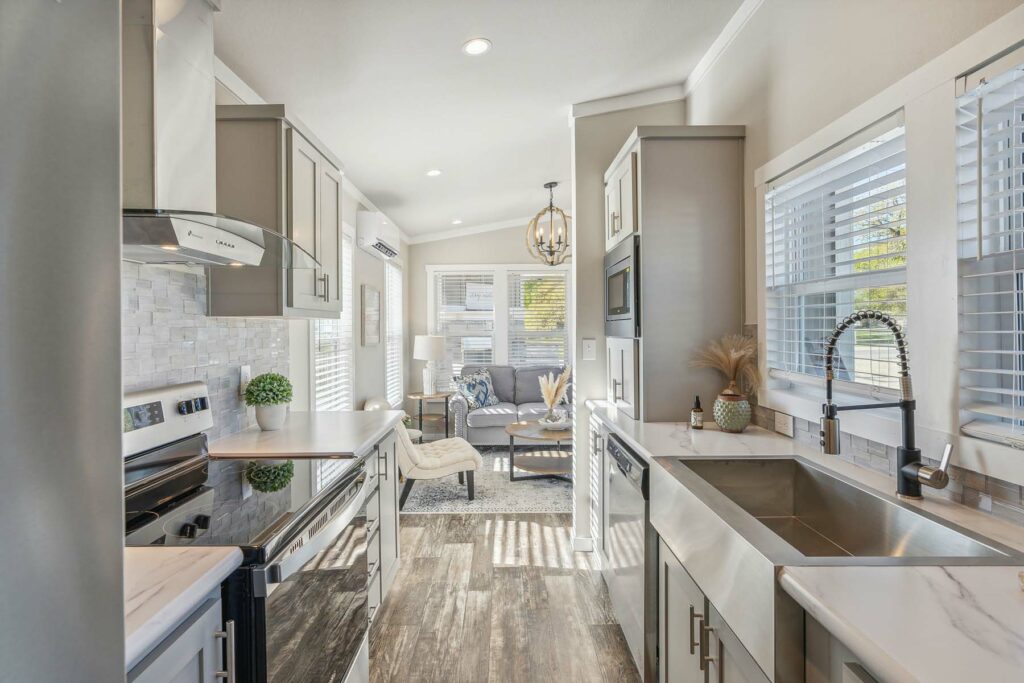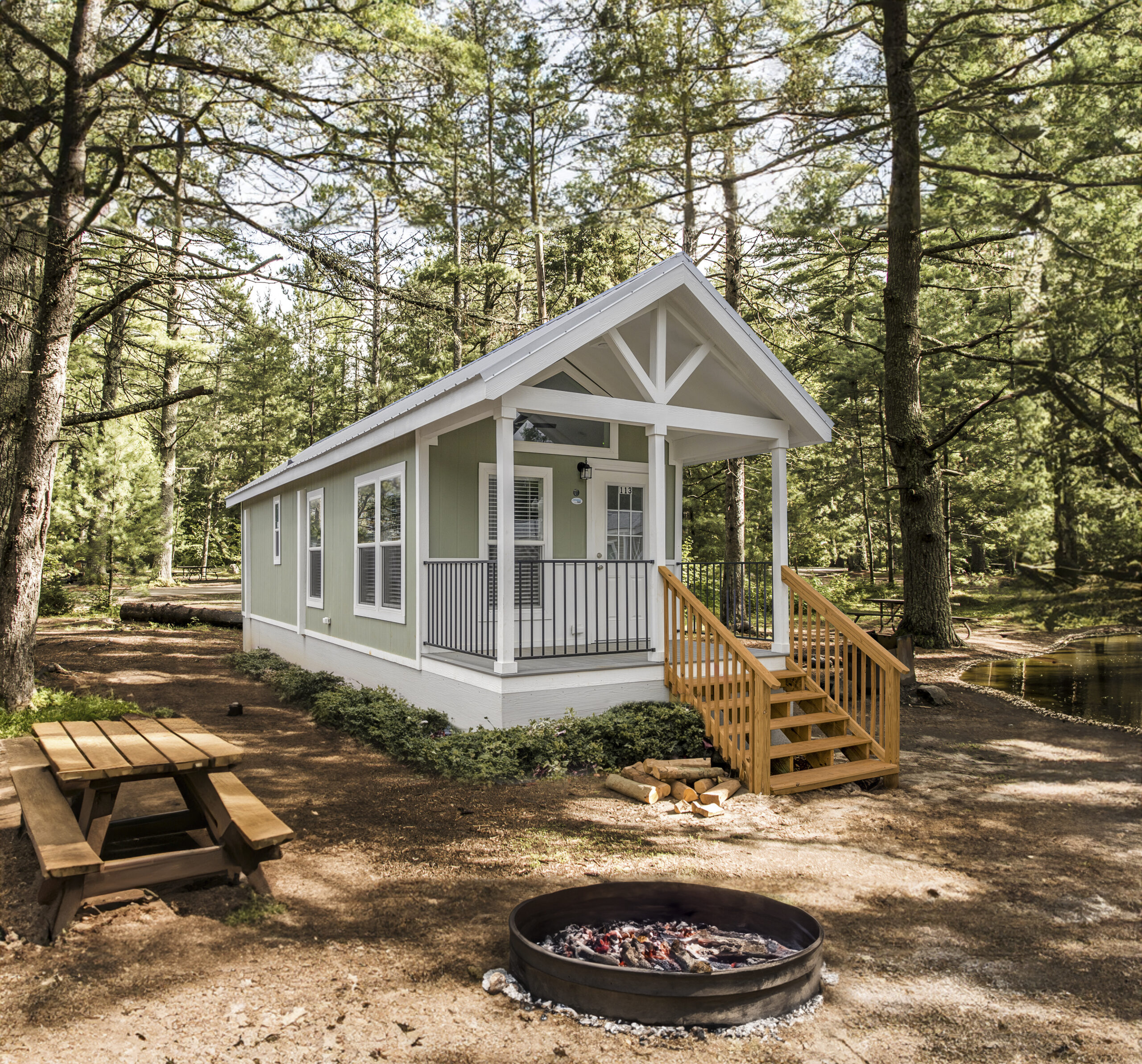The beauty of the RV lifestyle is that you can mobilize and see new places while remaining connected to work and family living “back home” or away from your traveling zip code. However, do you like to spend most or all of your time in the same destination every year? A hunting camp, RV resort, or lakeside retreat? It could be in a different state – say a seasonal spot located farther south during the winter months – or it could be within a few hours’ drive from your home and offers a retreat on weekends. Rather than driving your RV to these places, consider an RV that is a bit more established.
Enter “park models”. John Tuyo, Director of Park Model Sales for Champion Homes, spoke with us about park models – what they are, what you can expect when you’re looking at models, and Champion’s approach to manufacturing these impressive RVs. Champion Homes carries the bulk of the market share, with soon to be 16 manufacturing facilities across the United States. You’re never too far from this reputable retailer – and these incredible RVs.
What is a park model?
According to Go RVing, a park model offers more space than any other RV type and is designed to look like a home. At first glance, you might not even realize it’s an RV, complete with hitch and wheels, typically hidden underneath a skirt.
Tuyo explains that park models must be below a certain number of square feet in order to fall under the RV industry. “If we go over 400 square feet, that turns us into what they call a HUD, but a HUD park model is 400 to roughly 600 square feet. That’s governed by the U.S. Department of Housing and Urban Development.”
A park model from the outside looks much like your typical home, including a metal or shingled roof. You can choose to add on a back or front porch for extra living and entertainment space. “I can do anything as long as from a transportation standpoint, it’s legal to ship where they want to take it,” says Tuyo. The interior décor ranges from rustic to beachy to modern – it’s up to you and your taste.
According to the RVIA, nearly 70 percent of park model owners locate their unit within several hours’ drive time from their primary residences and use them for weekend camping trips. Other park model owners find a community in a destination state. For instance, they live in Michigan part of the year and in North Carolina another part of the year. A park model can make for a great option, instead of driving or towing down an RV, staying in a condo, or renting a house.
“I would say that if someone is looking for vacation areas, to look at park models as a distinct option due to the fact that you can rent a campsite, pull a fifth wheel RV, rent anything you want to rent [homes], but when you’re in a campground or specific community, being in a park model, you’re a part of a close-knit community,” says Tuyo.
How do you take ownership of a park model, and is there anything to set up?
“Park models are delivered by a semi to the location of your choice, whether it would be private land, a community, whatever. It may be a campground. Once it’s delivered, it’s in essence set up and it’s not moved again unless [the owner] decides to change communities or something else happens.
When the RV arrives, “you just let the air out of the tires, block the four corners, and tie it down three times on each side. And then you hook your electric, septic, and water up just as you do a camper. Generally, they’re 50- to 100-amp service, so you plug them in just like an RV,” explains Tuyo. “A park model takes about three hours to set up.” Then, you’re ready for rest and relaxation.
When might a park model make the most sense?
“If [you] drove a fifth wheel or a bumper pull every single year to Arizona, and went to the same general area every year, it would make sense to buy a park model and keep it in that general area in a community because it’s not necessary to tow it from Michigan to Arizona. At that point then, you would buy a park model in the community of your choice or on private land [in the area of your choice].”
Why do folks make the switch to a park model?
“It’s more that they want to stay somewhere for a longer period of time. It’s just a lifestyle. That’s generally where they want to retire or travel or vacation. And a lot of our communities are often areas found all across the country. If you want to, say, go to North Carolina, we have people over there who have communities that you can rent,” explains Tuyo. Many folks who choose park models choose them precisely for the close-knit community they can return to again and again.
Are park models intended for year-round living? They seem pretty comfortable.
“No,” says Go RVing. “Despite their residential appearance, park models are built to RV standards and are designed for short-term, recreational or seasonal use. They are fantastic to use for an entire season if you are expecting to spend several weeks or months in one location or spend multiple weekends at the same place in the same way others use a lake house or condo.”
“Remember, park models are meant for temporary housing. That keeps us under the RV Insignia. We are built to the RVIA code 119.5. We are meant for temporary housing,” explains Tuyo.
Park models are built to all different snow loads, according to Tuyo. And, the materials and overall construction do make park models superior to other RV types. “It’s more comfortable because it’s a metal roof or shingled roof. It’s more stable living. Full kitchens, dining rooms, front porches, you have just about anything you could ever want in a park model RV,” says Tuyo. “Plus, [the construction] gives you more peace of mind when it comes to rain, wind, and quiet when it’s time to go to bed.”
What are the options when it comes to floor plans, interior décor, and exterior appearance?
“We have a few different lines,” says Tuyo. “We have a hospitality line that you can get a normal size refrigerator side by side. Our inside amenities can be whatever the customer wants. Generally, we’re tape and texture on our park models, but we can do panelized insides to lower the price. We also do Southern Yellow Pine interior finish for the cabin look.”
If you visit Champion’s website, you can take a look at the floor plans available, as well as interior photos to get a feel for the aesthetics and level of comfort. Lofts are optional and can be added for an extra bedroom or hangout area. Kitchens are generally large and welcoming, the living area more spacious. Higher ceilings, more windows, more light, and comfortably sized bedrooms make you forget that you’re in an RV at all. Basically, anything you can think of as long as it all fits within 399 square feet.
“We have base models all across the country, so normally if someone has seen it or thought about it, we have already done it. We can do some customization that is allowed, it just depends on the area of the country they want to go to.”

What about pricing? There’s probably quite the range based on customization.
“From a retail customer perspective,” explains Tuyo, “you’re anywhere from $70K to $400K if you’ve got the land costs or site rent to go with it. But generally, for around $100,000 you can purchase one and then you have lot rent or property costs.” There is a degree of customization available for park models, which affects price. Tuyo says that Champion has many, many floor plans available and has probably created park models of nearly every conceivable combination.
Compared to the price of other types of RVs, park models can offer an alternative and affordable option – plus, it’s definitely lower cost that building a residential structure from the ground-up.
Why is it important to go through a licensed dealer?
“The reality is you have to go through a retailer or dealer who has a state license,” explains Tuyo. “Because we are licensed through the Secretary of State, park models are RVs just like your fifth wheel. Folks go through our network, so we either have communities we sell or street retailers, if you will, that can make that dream happen and just get it set up and have it ready to go when [the customer] get there.
“We deliver park models all across the country. We are the nation’s largest park model and cabin builder in the country. From Michigan, the nearest manufacturing locations are in Wisconsin and Pennsylvania,” says Tuyo.
Visit Champion Park Models and Cabins, a MARVAC member, at www.championparkmodelscabins.com.

